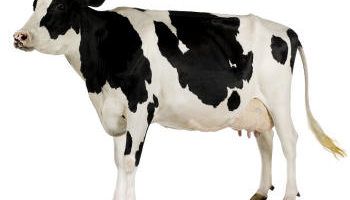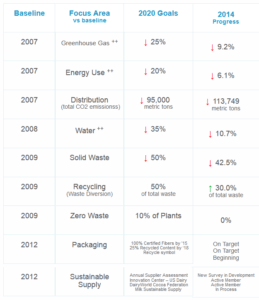Dean Foods: Udderly Sustainable?

Dean Foods, America's largest processor of milk, is directly dependent on government controlled prices for raw milk. Does this expose Dean to financial pressures due to climate change?
Dean Foods – Udderly Sustainable?
Will household brands like Dean be impacted by climate change?
Dean Foods is the largest processor and “direct-to-store” distributor of fresh milk and other dairy products in the United States with net 2015 sales of $8.1 billion (1). Raw milk and butterfat, the primary raw material in Dean’s products, are sourced directly from cooperatives and independent farmers across the country (1). Prices for raw milk and butterfat are established by federal and state governments (1). As such, the cost of goods produced for Dean Foods is directly dependent on both farming conditions and yield as well as government regulation. In addition, costs of a fossil fuel based resin used in plastic bottle packaging and diesel fuel consumed in the “direct-to-store delivery” system are subject to market price fluctuations (1). As profits are highly contingent on prices of raw milk and other commodities, Dean is financially exposed to external factors, including climate change and environmental regulations. Will Dean be able to sustain climate change long-term?
How does climate change impact raw materials?
Rising greenhouse gas concentration is leading to rising global temperature as well as changing weather patterns. Extreme drought has swept the western United States since 2013 and many nations around the world are experiencing pressure on water supply (2). Global demand for water may outstrip demand by 40% by 2030 (2).
Rising temperatures and unpredictable weather patterns impact yield in milk production. According a 2014 USDA Economic Research Service report, dairy cows are sensitive to heat stress and increasing temperatures can result in decreased milk output (3). To mitigate heat stress, farmers must incur capital costs to provide shading and cooling structures (3). In 2010, heat stress led to S1.2 billion in lost production for the entire dairy sector (3). Furthermore, the USDA estimates that, assuming an increase of 1.45 to 2.37 °F by 2030 and adjusting for milk prices, may lower producer welfare by $42-$108 million for in milk production costs (3). In addition to rising temperatures, drought conditions may impact water supply and feed availability, which may, in turn, impact milk production (4). Decreases in production efficiency resulting in supply shortage or cost increase may transitively impact the cost of goods sold for Dean.
Dean would be exposed to future regulations limiting greenhouse gas emissions, if implemented. Cows produce significant amounts of methane as a byproduct of milk production. Dairy methane emissions accounted for 11% of total US methane emissions in 2013 (5). Any imposed restriction on future emissions of methane, therefore, may impact the supply and price of raw milk and buttermilk. Similarly, cost of resins used in packaging and diesel used in the extensive distribution system are susceptible to fluctuation with changes in fossil fuel pricing.
What is Dean doing to combat climate change?
Dean has already begun to reduce its overall footprint by improving emissions, reducing water usage, and minimizing waste (see Exhibit 1). Dean’s active improvements to reduce its own negative impact across its plants helps to slow the climate change that may ultimately put the business at risk. As of 2014, Dean had reduced their absolute greenhouse gas emissions by 25% and their greenhouse gas emissions per gallon of product by 9% relative to a 2007 baseline (6). Furthermore, Dean has implemented renewable energy alternatives in several locations, including biogas plants in Franklin and Lynn, Massachusetts to convert methane from waste water into electricity, as well as solar energy in Rensselaer, N.Y. Both renewable solutions contribute directly to reduction in greenhouse gas emissions (6).
Exhibit 1: Environmental Sustainability Metrics (6)
Dean has also taken action to work directly with farmers to improve methane emission from livestock. In 2012, Dean Partnered with AgPower Partners to build an anaerobic digester at Big Sky West Dairy farm near Gooding, Idaho to capture animal waste and convert methane into renewable energy (6). This initiative is an example of a method to reduce the overall footprint of milk production as well as lower the risk of farmers to increased costs due to any future emissions restrictions or regulations, if implemented.
What else can Dean do?
As milk yield and price is susceptible to water availability for feed and animal health, Dean may benefit from reviewing potential impact of water shortage and working throughout its entire supply chain to develop risk mitigations (4).
Dean has already experimented with pilot hybrid refrigerated trucks as a potential reduction in diesel consumption (6). Additionally, Dean may evaluate other efficiencies like replacement of fossil fuel based resins in bottle production to reduce dependency on fossil fuel prices.
Despite significant progress and attention in reducing its own manufacturing footprint, Dean may continue to decrease exposure to climate change through innovative farming solutions and advances in packaging and distribution. The price of our milk may depend on it!
(798 Words)
References
- Dean Foods. 2015 Annual Report. http://www.deanfoods.com/pdfs/annualreport.pdf, accessed November 2016.
- Henderson, Rebecca M. et al. “Climate Change in 2016: Implications for Business,” HBS No. N2-317-032 Boston: Harvard Business School Publishing, 2016.
- Key, Nigel et. al. “Climate Change, Heat Stress, and U.S. Dairy Production.” USDA Economic Research Report, September 2014, http://www.ers.usda.gov/webdocs/publications/err175/49163_err175_summary.pdf, accessed November 2016.
- “Dean Foods report on water risk mitigation in dairy supply chain,” Ceres, https://www.ceres.org/investor-network/resolutions/dean-foods-report-on-water-risk-mitigation-in-dairy-supply-chain, accessed November 2016.
- “Reducing the Emissions Intensity of Livestock production: Case Studies of Success,” Global Research Alliance on Agricultural Greenhouse Gases, http://globalresearchalliance.org/wp-content/uploads/sites/4/2015/11/USA-national-dairy-CH4.pdf, accessed November 2016.
- Dean Foods, “Environmental Responsibility.” http://responsibility.deanfoods.com/environmental-sustainability, accessed November 2016




Great post. I think the feed/water sensitivity issue is a great point and an underrated area of sensitivity that Dean has to climate change. I think there are two things that Dean could do to mitigate this. First, I wonder to what extent Dean can influence their suppliers to consider tweaking their feed mix to include less “thirsty” plant inputs. While it may result in higher input costs in what is essentially a commodity product, Dean could have the clout to cause an industry shift a la IKEA. Second, given that climate change has lead to increased precipitation in certain parts of the US, Dean could consider shifting its supply chain to focus more on dairy farmers located in areas with lower drought risk.
Really interesting post, especially when you consider that methane emissions from agriculture increased by 11% from 1990 to 2013 while the contribution from the energy decreased over that same time period[1]. I like Sam’s suggestion of adjusting the feed mix to include less thirsty plant inputs – perhaps it could also be altered to yield less methane production from the cows? The article cited above mentions that as a possibility, as well as using antimethane additives, experimental vaccines, or even using genetics to develop and breed cows that naturally produce less methane. However, some of those options (e.g., vaccines or genetic alterations) could surely be controversial and potentially have other side effects.
[1] Laura Beil, “Getting creative to cut methane from cows”, Science News, November 18, 2015, https://www.sciencenews.org/article/getting-creative-cut-methane-cows, accessed November 2016.
As you touch upon in your article, the government is involved in pricing milk and dairy products; this is primarily driven by the importance of milk in our diet, and thus to ensure that this is priced low enough to promote consumption. Given the impact that dairy farming has on the environment, how far should governments take their duty to regulate the industry from an environmental standpoint?
When considering this, it is interesting to read the measures that the Californian government attempted to take (https://www.theguardian.com/environment/2016/aug/10/cow-methane-reduction-california-dairy-industry). The California Air Resources Board (ARB) targeted the belching/farting of dairy cows, but were met with strong opposition by the dairy industry who claimed that these gut microbial interventions may put the health of their cows in danger. Is this truly the case or is there simply too much inertia in this very traditional industry? And is the US government being creative enough in tackling the problem of methane emissions with dairy farmers? The Argentinian government for example has designed methane backpacks for its cows to convert their emissions into green fuel (http://www.springwise.com/methane-backpacks-capture-cow-farts-turn-green-fuel/) – could this be a reasonable consideration?
Really interesting piece! One thought I had was about the demand for milk and how that plays into Dean’s business. Milk has been consumed less and less in the US for some time as myths about how healthy it was for you have become debunked, and the healthy trend persists. Increasingly, lactose intolerance or insensitivity has been embraced and so I wonder if that may also have an impact on how much milk is produced and therefore the effects on the environment. What other products might Dean consider producing to mitigate this, and what impact will the production of those products have on the environment?
Dean the poster, I’ll be honest — I never considered how big of a role cow farts, burps, and poops played in global warming. So thank you for your post.
Now, I’m thinking about what else Dean the company might be able to do to encourage farmers to (1) protect their cows from heat stress to limit loss in dairy production, and (2) prevent these gentle creatures from trashing our atmosphere so much with their expelled methane. I like the idea of studying antibiotics, diet mix, and even genetic engineering to cut down on the gas, as discussed above. This might be a stretch, but I wonder if anyone has studied the idea of trapping the methane at its source (the cow) and potentially even store it to serve a better use. I don’t know how far away we are from witnessing the arrival of large-area biodomes, but it seems like such a device could – in theory – prevent livestock methane from escaping into the atmosphere, while simultaneously protecting the animals from excess heat.